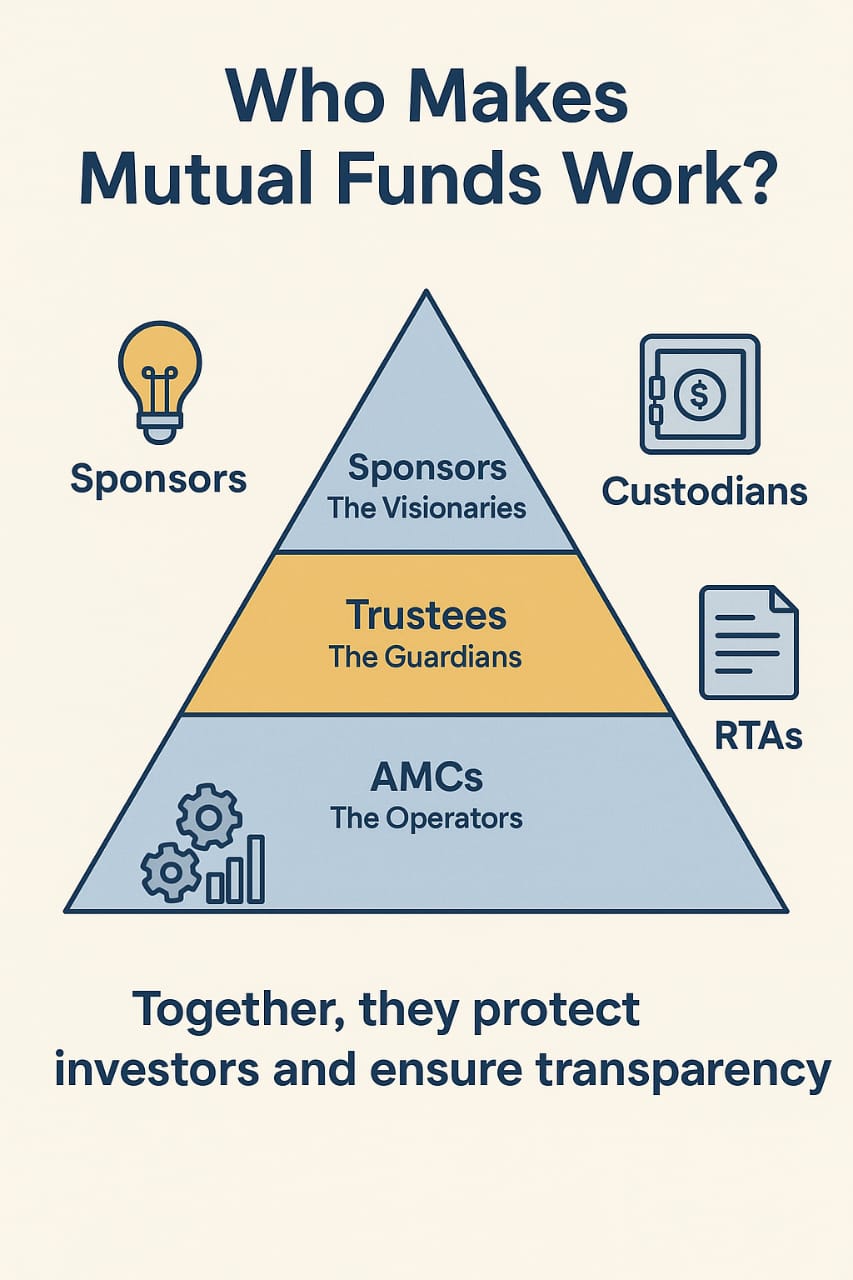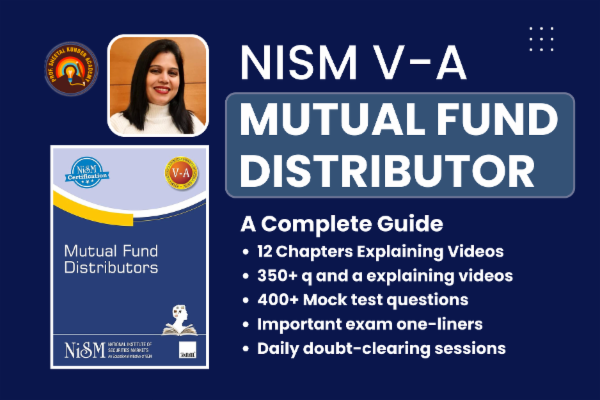There are no items in your cart
Add More
Add More
| Item Details | Price | ||
|---|---|---|---|
| How The Complete Mutual Fund Industry Works In India (basic to advanced structure)? |
Sat Sep 27, 2025
In today’s financial landscape, mutual funds have become a cornerstone for both beginner and seasoned investors. They offer diversification, professional management, and accessibility, which is why millions of investors in India and around the world trust them for long-term wealth creation. However, behind this seemingly simple product lies a well-defined structure with multiple participants ensuring smooth functioning, investor protection, and regulatory compliance.
This blog explores mutual funds in depth — their three-tier structure, the role of sponsors, trustees, AMCs, custodians, and RTAs, along with insights into SEBI’s regulatory oversight. By the end, you will understand not only how mutual funds work but also why they are considered a safe and transparent investment option.

The Three-Tier Structure of Mutual Funds
Mutual funds operate under a three-layered legal framework designed to protect investors while maintaining efficiency.
Sponsors – The Visionaries
Sponsors are similar to company promoters. They create the foundation for the mutual fund, set objectives, and bring in the initial capital. Importantly, sponsors are not the ultimate beneficiaries. Their role is to set up the fund. For example, Tata Mutual Fund is sponsored by Tata Sons Pvt. Ltd. and Tata Investment Corporation. Sponsors define fund objectives, bring credibility, and appoint trustees. They also provide the initial funds to establish the mutual fund.
Trustees – The Guardians of Investors’ Interests
Trustees are appointed to safeguard investors’ money. Acting like the directors of a company, trustees ensure that the fund operates within SEBI’s rules. They oversee the AMC’s performance, review compliance reports, and take corrective measures if needed. SEBI prohibits AMC directors or employees from acting as trustees. Independent trustees must have no connection with the sponsor or AMC, ensuring unbiased decision-making. Trustees also have the authority to replace an AMC if it underperforms or breaches compliance, provided they have the approval of 75 percent of unitholders.Asset Management Company (AMC) – The Operators
The AMC manages day-to-day operations, including investment decisions, research, marketing, and compliance. Fund managers and analysts employed by the AMC make investment calls aligned with the scheme’s objectives. For example, HDFC Asset Management Company manages schemes under HDFC Mutual Fund. The AMC is responsible for selecting securities, balancing portfolios, monitoring fund performance, and investor communication.Together, this three-tier system ensures that no single entity has unchecked power, reducing conflicts of interest and building investor confidence.
Supporting Participants in Mutual Funds
Beyond the core structure, other entities play crucial roles in ensuring smooth functioning.
Custodians
Custodians act like banks for mutual funds, holding the purchased securities safely. They manage dividends, bonus shares, and other corporate actions. Usually, large financial institutions such as HDFC Bank or ICICI Bank serve as custodians.Registrars and Transfer Agents (RTAs)
RTAs handle administrative tasks, such as maintaining investor records, processing redemptions, dividend payouts, and changes in investor details. For instance, CAMS (Computer Age Management Services) and KFin Technologies are leading RTAs in India.Compliance Officers
Every AMC appoints a compliance officer who ensures SEBI regulations are followed. They act as watchdogs, ensuring no deviation from rules and reporting discrepancies directly to trustees.These players may work behind the scenes, but their contribution is critical for maintaining investor trust.
Click Here to Enrol for NISM VA Complete Guide
SEBI’s Role: Ensuring Transparency and Protection
The Securities and Exchange Board of India (SEBI) is the governing authority that regulates mutual funds. SEBI has put in place strict rules to ensure investor protection.Trustees, AMCs, and custodians must remain independent of one another. If an AMC makes fundamental changes affecting the risk profile of a scheme, investors must be informed and given the option to exit. Major changes in fund management require SEBI’s prior approval. AMCs must submit detailed compliance reports and disclosures to both trustees and SEBI.This regulatory framework ensures that mutual funds remain one of the most transparent investment vehicles available.
How AMCs Function
The AMC’s role is often misunderstood as merely buying and selling securities, but its scope is far broader.Fund management involves constant monitoring and restructuring by fund managers in active schemes, whereas passive funds simply track indices. Marketing and distribution are also key functions, as AMCs employ dedicated teams to promote schemes, especially open-ended ones, to attract investors. Through RTAs, AMCs handle redemptions, transfers, and investor grievances. They also monitor market risks and adjust portfolios accordingly.An AMC is essentially the engine of the mutual fund system — keeping operations running, compliance in check, and investors informed.
Active vs Passive Fund Management
Investors can choose between two broad categories of funds.
Active Funds involve fund managers who use expertise and market research to outperform benchmarks. For example, an actively managed mid-cap equity fund will try to beat the Nifty Midcap 150 index.
Passive Funds replicate a benchmark index with minimal intervention, making them low-cost and transparent. Examples include Index Funds and Exchange-Traded Funds (ETFs). The choice depends on an investor’s risk appetite and financial goals.
Real-World Example: Tata Mutual Fund Structure
To illustrate, let us look at Tata Mutual Fund.
Career Opportunities in Mutual Funds
The mutual fund industry is not just about investments. It offers a wide range of career opportunities.
A mutual fund distributor is a licensed intermediary who sells schemes to investors. Fund managers and analysts research, track, and select securities. Compliance officers ensure SEBI rules are followed. Operations executives manage back-end functions such as reporting and investor records.
As India’s mutual fund industry continues to grow, these career paths are becoming increasingly lucrative.
Conclusion
Mutual funds may appear simple on the surface, but they operate on a robust three-tier structure designed to protect investors and maintain transparency. Sponsors create the vision, trustees guard investor interests, AMCs manage day-to-day operations, while custodians and RTAs ensure security and administration.
Thanks to SEBI’s strict regulatory framework, mutual funds have emerged as one of the most trustworthy and accessible investment avenues for retail and institutional investors. Whether you are an investor seeking wealth creation or a professional exploring a career in capital markets, understanding the inner workings of mutual funds is the first step to long-term success.

Prof. Sheetal Kunder